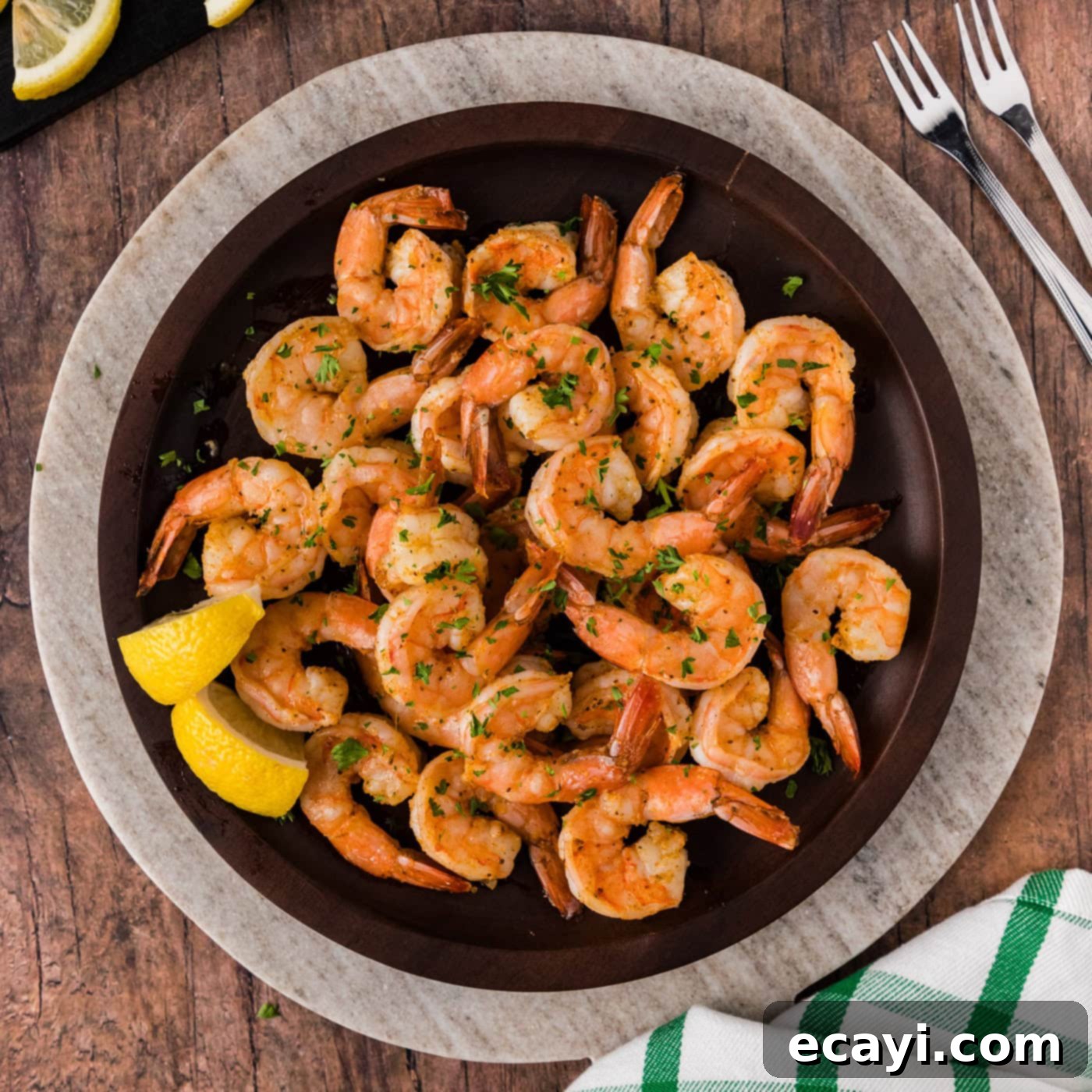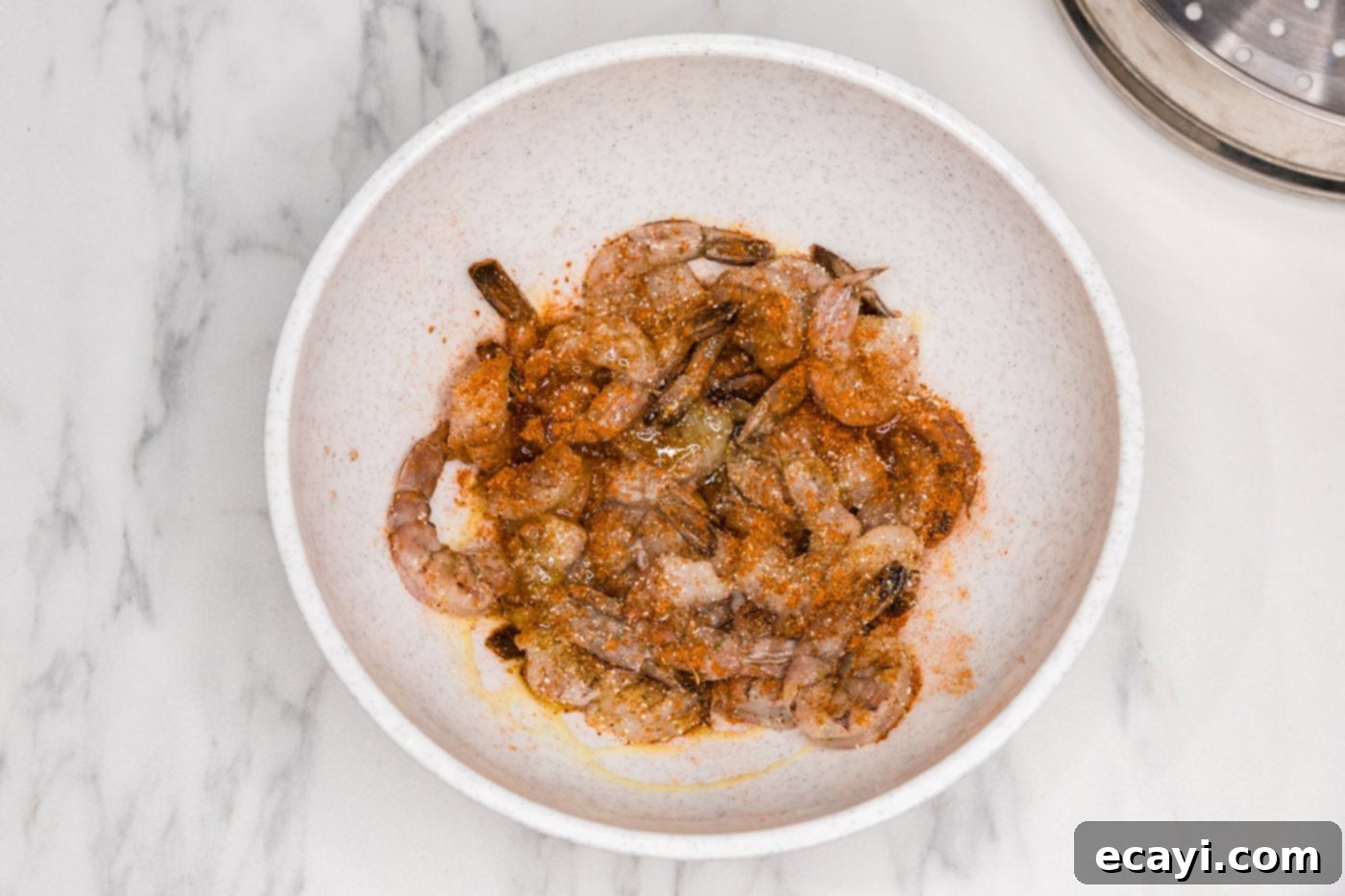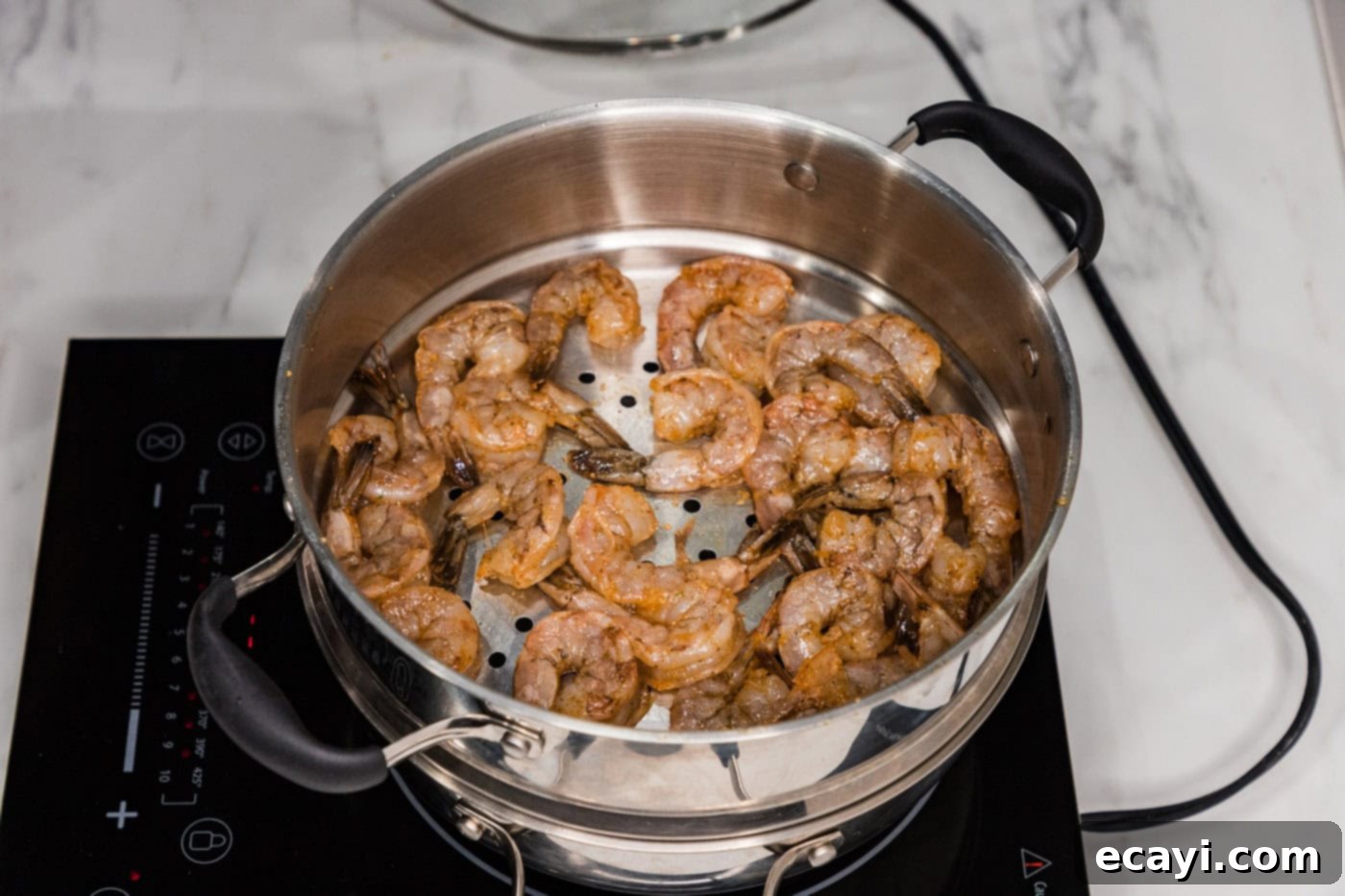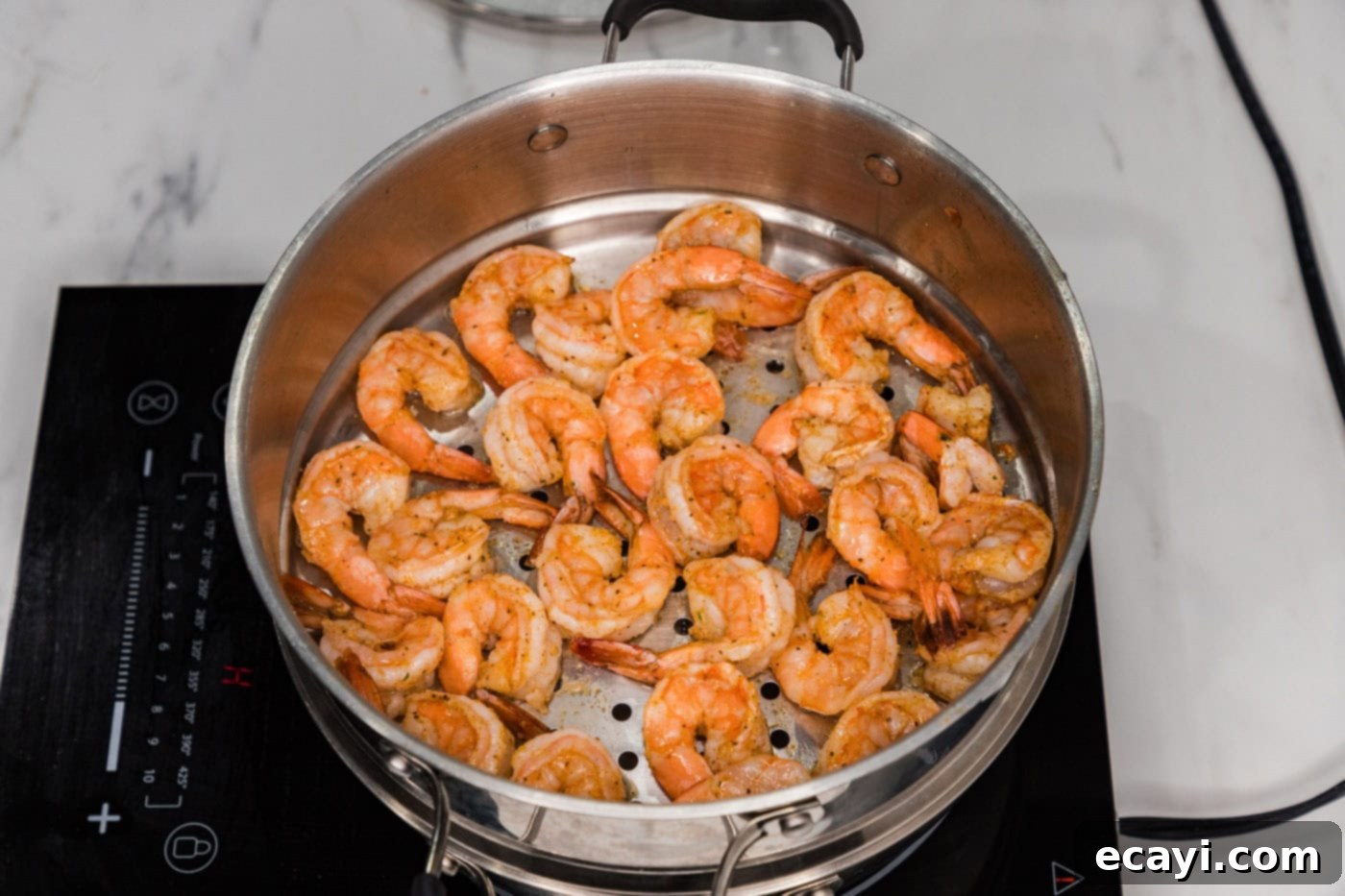Perfectly Steamed Shrimp: An Easy 10-Minute Recipe for Tender, Flavorful Seafood
Unlock the secret to incredibly tender, juicy shrimp in just 10 minutes with this foolproof steaming method. Requiring only four simple ingredients, this recipe transforms raw shrimp into a succulent dish that’s bursting with flavor, without being greasy or heavy. Whether you’re a seasoned chef or a kitchen novice, you’ll achieve perfectly plump shrimp every single time, making it an ideal choice for a quick weeknight dinner, a healthy appetizer, or a versatile protein addition to countless meals.
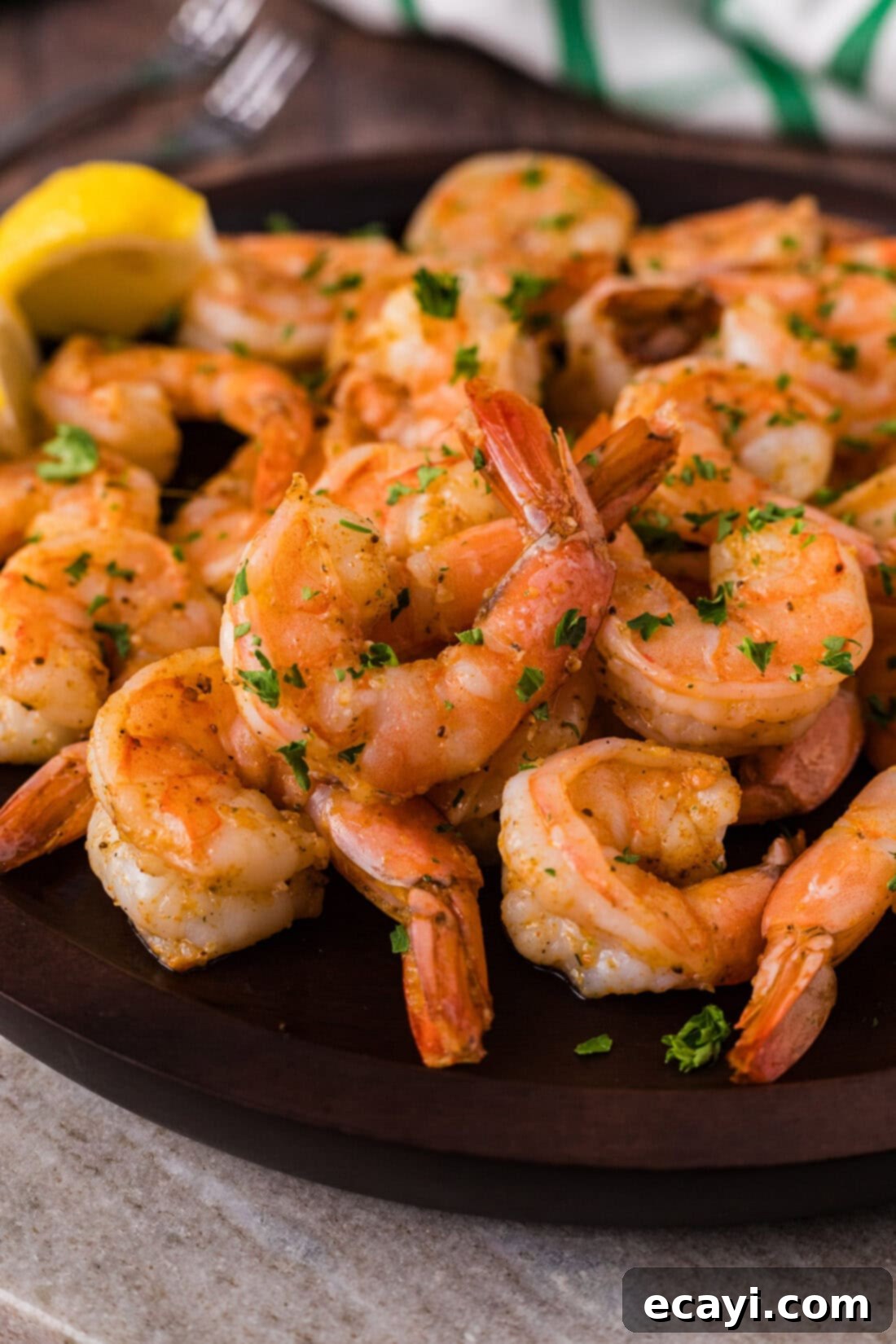
Why This Simple Steamed Shrimp Recipe is a Game-Changer
Steaming shrimp is not just easy; it’s arguably one of the healthiest and most effective ways to cook this popular seafood. This particular recipe stands out because it maximizes flavor with minimal effort and ingredients, delivering consistent results that are tender, never rubbery. Here’s why this steamed shrimp recipe will become a staple in your kitchen:
- Unbeatable Simplicity: With only four ingredients – shrimp, olive oil, Old Bay, and garlic salt – and a cooking time of just 5-7 minutes, it’s virtually impossible to find an easier seafood dish. This recipe is designed for those busy days when you crave something delicious and wholesome without spending hours in the kitchen.
- Perfect Texture Every Time: Steaming is a gentle cooking method that ensures the shrimp retains its natural moisture, resulting in a plump, succulent texture. Unlike pan-frying or grilling, there’s less risk of drying out the shrimp, guaranteeing a tender bite with every piece.
- Balanced Flavor Profile: The combination of Old Bay seasoning, garlic salt, and a touch of olive oil creates a harmonious blend that enhances the shrimp’s natural sweetness without overwhelming it. Old Bay, a classic seafood seasoning, provides a savory, slightly spicy kick, while garlic salt adds aromatic depth. The olive oil helps these seasonings adhere beautifully and adds a subtle richness.
- Healthy and Light: Steaming requires no added fats beyond a drizzle of olive oil for flavor, making this a wonderfully light and healthy meal option. It’s an excellent source of lean protein, low in calories, and packed with essential nutrients, making it perfect for various dietary preferences.
- Incredibly Versatile: Once cooked, these steamed shrimp can be enjoyed in a multitude of ways. Serve them hot or cold, as a main course, an appetizer, or as a protein booster in salads, pasta, tacos, and more. Its simple seasoning makes it a blank canvas for various culinary creations.
This recipe embodies convenience, health, and flavor, making it exactly what you need for a delicious meal when you’re short on time but unwilling to compromise on taste or quality. While there are countless ways to prepare shrimp, from sautéed to baked and grilled, this steaming method offers a uniquely delicate and satisfying outcome that is truly a personal favorite.
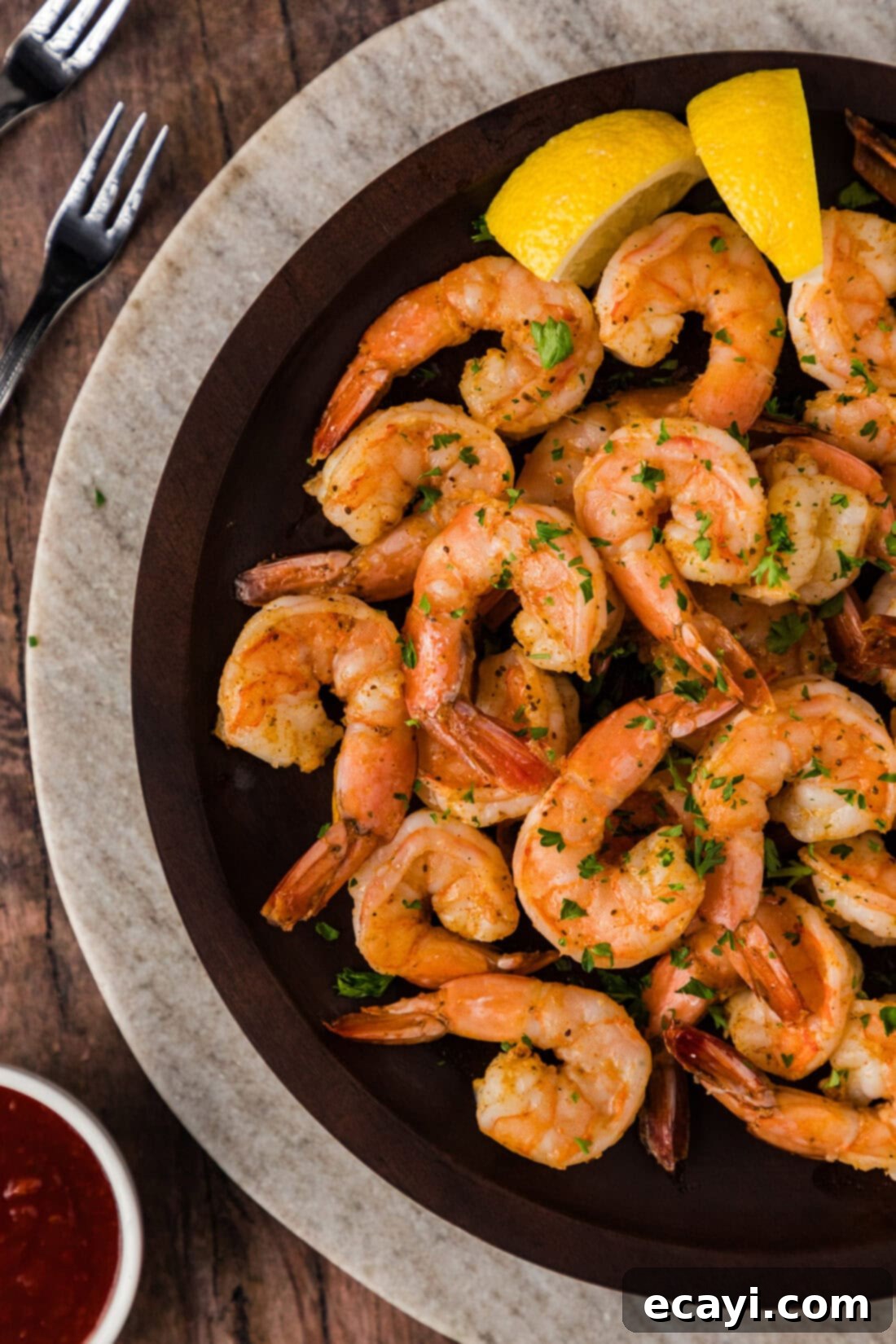
Essential Ingredients for Flawless Steamed Shrimp
You’ll be amazed at how few ingredients are required to create such a flavorful dish. For precise measurements, detailed instructions, and nutritional information, refer to the printable recipe card at the conclusion of this article. For now, let’s dive into the core components:
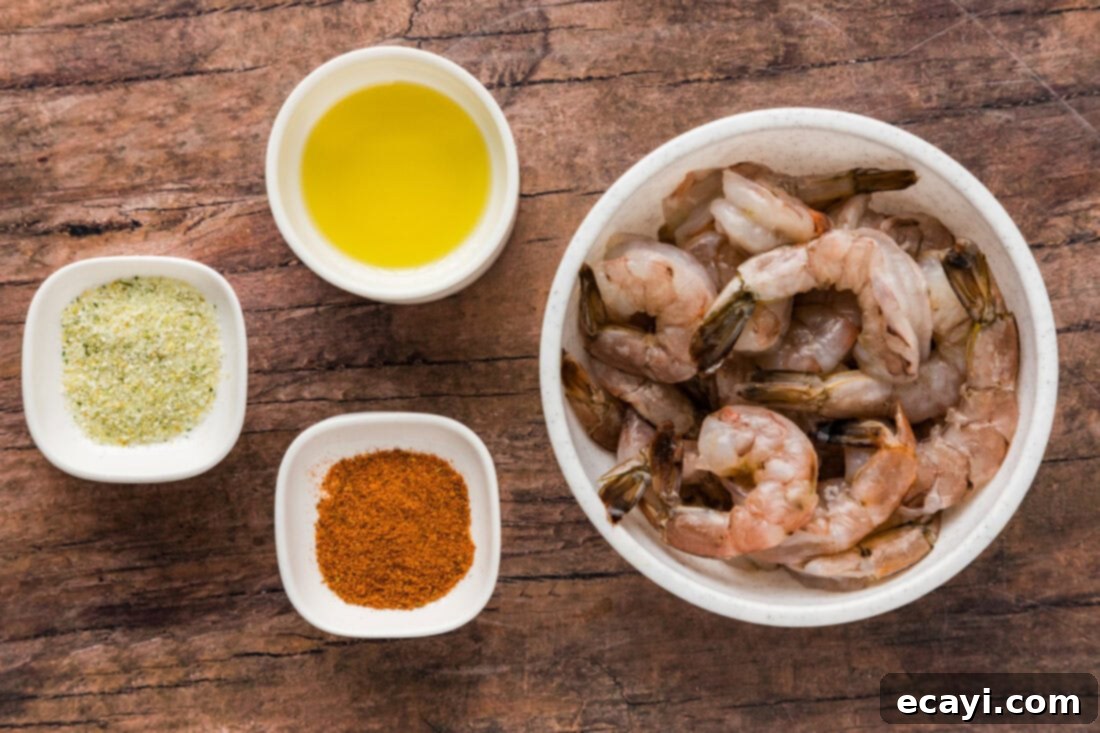
Ingredient Spotlight & Expert Substitution Tips
Each ingredient plays a crucial role in the success of this simple steamed shrimp recipe. Understanding their purpose and potential substitutions will help you customize this dish to your liking.
SHRIMP – The star of our dish! You will need one pound of high-quality large raw shrimp, preferably peeled and deveined. This ensures they are ready to season and cook without extra prep time. The “large” size is recommended as it cooks evenly and remains succulent. If you opt for smaller shrimp, reduce cooking time slightly; for colossal shrimp, you might add an extra minute. You can absolutely use frozen shrimp, which is often more readily available. The key is to ensure it is completely thawed before seasoning. This allows the olive oil and spices to properly adhere to the shrimp, rather than slipping off watery surfaces, ensuring every bite is seasoned to perfection. For best results, choose wild-caught shrimp for superior flavor and texture, though responsibly farmed shrimp is also a good option.
SEASONING – The dynamic duo of Old Bay seasoning and garlic salt provides a robust and classic flavor foundation. Old Bay brings its signature blend of savory herbs and spices, a true taste of coastal cuisine, while garlic salt infuses a pungent, salty kick that complements seafood beautifully. Feel free to experiment with your favorite seasonings! For a different twist, consider lemon pepper, a dash of paprika for color and mild heat, or a sprinkle of onion powder. If you prefer a bolder profile, a pinch of cayenne or a tablespoon of homemade shrimp seasoning (which often includes paprika, onion powder, and dried herbs) would be excellent. You can also finish the cooked shrimp with a squeeze of fresh lemon juice and chopped fresh parsley for a brighter, herbaceous note.
OLIVE OIL – A tablespoon of olive oil is essential for two main reasons: it helps the dry seasonings cling to the surface of the shrimp, ensuring an even coating, and it adds a subtle richness and gloss to the cooked shrimp. Extra virgin olive oil is recommended for its superior flavor, but any good quality olive oil will work. You can also use a neutral oil like avocado oil if preferred, though olive oil offers a nice Mediterranean undertone.
Step-by-Step Guide: How to Achieve Perfectly Steamed Shrimp
These step-by-step photos and detailed instructions are designed to help you visualize each stage of making this delicious recipe. For a convenient printable version with exact measurements, simply jump to the full recipe card at the bottom of this post.
- Season the Shrimp: Begin by placing your peeled and deveined raw shrimp in a large mixing bowl. Sprinkle generously with garlic salt and Old Bay seasoning. Ensure you distribute the seasonings evenly over all the shrimp for maximum flavor in every bite.
- Add Olive Oil and Toss: Drizzle the olive oil over the seasoned shrimp. Gently toss the shrimp with your hands or a spoon, ensuring that each piece is thoroughly coated with both the oil and the spices. The olive oil acts as a binder, helping the seasonings adhere perfectly to the shrimp.

- Prepare the Steamer: Pour enough water into the bottom of your steam pot to reach about an inch or so up the sides. Ensure the water level is below the bottom of your steamer basket, so the shrimp doesn’t sit in the water. Bring the water to a rolling boil over medium-high heat. This creates the necessary steam for cooking.
- Load the Steamer Basket: Carefully place the seasoned shrimp into the top basket of the steam pot. Arrange them in a single layer if possible, or avoid overcrowding, to allow the steam to circulate freely around each piece. This promotes even cooking.

- Steam the Shrimp: Once the water is boiling, place the steamer basket securely over the boiling water and cover the pot tightly with its lid. The lid is crucial for trapping the steam, which cooks the shrimp efficiently and gently.
- Cook to Perfection: Allow the shrimp to cook for 5-7 minutes. The exact cooking time will depend on the size of your shrimp. They are done when they turn opaque pink and curl into a “C” shape. Be careful not to overcook, as this is when shrimp can become rubbery. For smaller shrimp, check at 4-5 minutes; for very large or colossal shrimp, you might need up to 8 minutes.

Frequently Asked Questions & Expert Tips for Steaming Shrimp
Absolutely! Frozen shrimp is perfectly fine to use and often more convenient. However, it’s crucial to thaw the shrimp completely before you begin the seasoning process. If you season frozen or partially frozen shrimp, the melting ice will dilute your seasonings and prevent the olive oil from adhering properly, causing all that delicious flavor to wash off as it steams. To thaw frozen shrimp quickly and safely, place them in a sealed ziptop bag and submerge it in a bowl of cool water. The shrimp should thaw in about 30-45 minutes, depending on the amount. Change out the water every 15 minutes or so to keep it cool. Never thaw shrimp in warm or hot water, as this can encourage bacterial growth and negatively impact texture. Once thawed, gently pat the shrimp dry with paper towels to ensure optimal seasoning adhesion.
No problem at all! You can easily create a makeshift steamer using equipment you likely already have in your kitchen. Simply place a heat-safe colander (metal is ideal) inside a large pot that is deep enough for the colander to sit above the water level, allowing the lid to fit tightly on top. Alternatively, you can place a heat-safe plate on top of a few crumpled balls of aluminum foil or an upside-down ramekin inside a pot with an inch of water, ensuring the water doesn’t touch the plate. Cover the pot tightly, and you’re good to go. Many culinary stores also sell individual collapsible steamer baskets that fit into various pot sizes, which are a very inexpensive and versatile tool to have.
To maintain freshness and safety, allow any leftover steamed shrimp to cool completely before transferring it to an airtight container. Store this container in the refrigerator, where the shrimp will remain fresh and delicious for up to 3 days. Beyond that, the quality and safety can diminish.
Reheating shrimp can indeed be tricky, as overcooking quickly leads to a rubbery texture. Avoid the microwave if possible, as it tends to cook unevenly and quickly overcook delicate seafood. The best methods are “low and slow.” You can reheat steamed shrimp in a skillet: add a splash of water or broth to the pan, place the shrimp in, cover with a lid, and cook over low heat for just a few minutes until warmed through. Alternatively, reheat them in an oven preheated to 275°F (135°C) for about 8-10 minutes. The goal is to gently warm them without cooking them further, preserving their tender texture.
The visual cues are your best guide! Raw shrimp is typically grey and translucent. As it cooks, it will turn opaque pink and curl into a loose “C” shape. If it forms a tight “O” shape, it’s likely overcooked. A slightly curled “C” is ideal for maximum tenderness. The exact cooking time will vary based on the size of your shrimp, so always rely on these visual indicators rather than strict timing alone.
Absolutely! Steaming is a fantastic way to cook vegetables. For best results, add quick-cooking vegetables like asparagus spears, broccoli florets, snap peas, or sliced bell peppers to the steamer basket during the last 2-3 minutes of the shrimp’s cooking time, or steam them separately if they require more time (e.g., firmer vegetables like carrots or potatoes). This allows you to create a complete, healthy meal in one go.
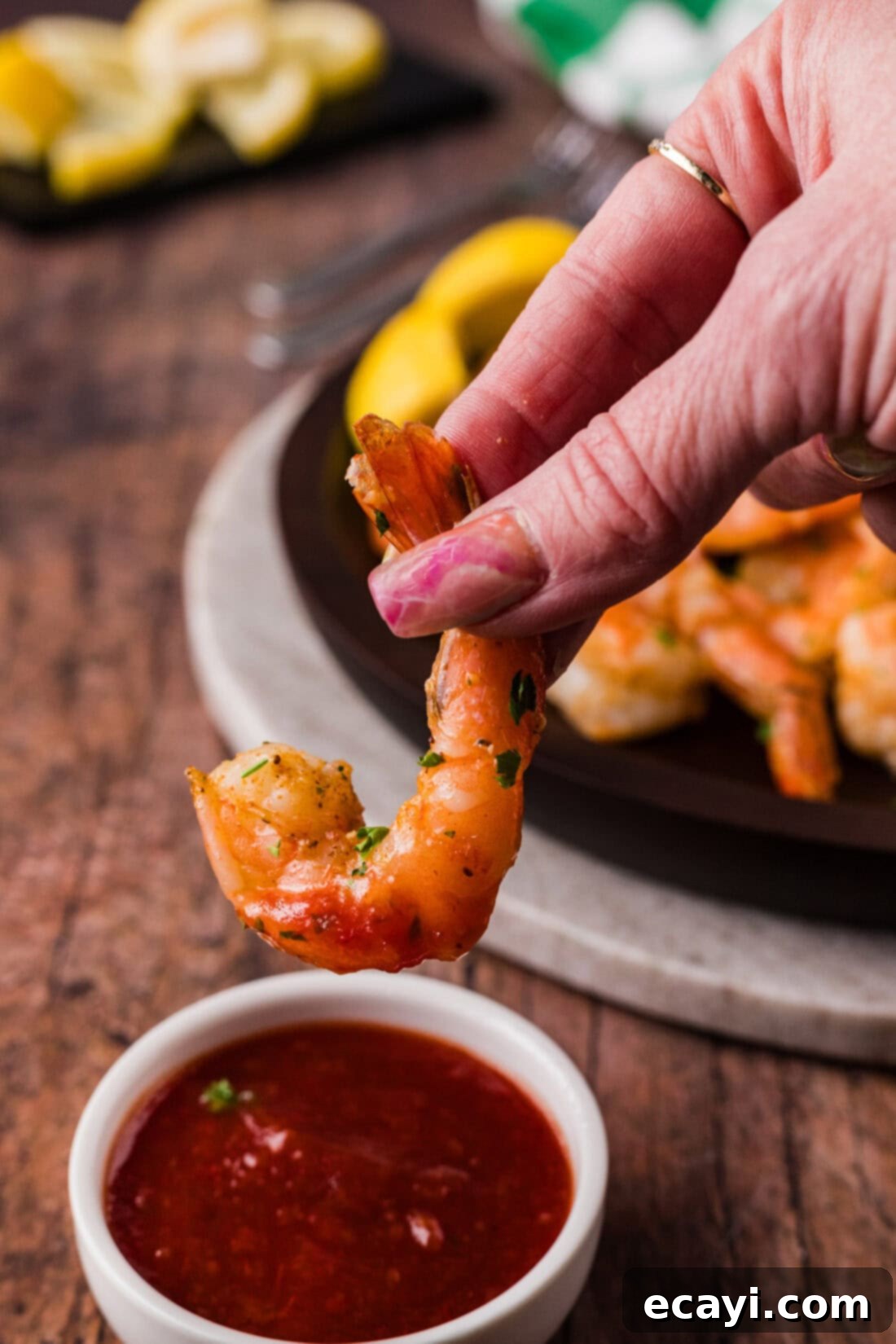
Creative & Delicious Serving Suggestions
The beauty of perfectly steamed shrimp lies in its versatility. Its delicate flavor profile makes it a superb base for a variety of accompaniments and meal ideas, whether served hot or cold. Here are some delectable ways to enjoy your freshly steamed shrimp:
- Classic Dipping Sauces: The most popular way to enjoy steamed shrimp is with a flavorful dipping sauce. Options include tangy cocktail sauce, creamy garlic aioli, rich garlic butter, or sweet and spicy Asian sweet chili sauce. For a lighter touch, a simple squeeze of fresh lemon juice is wonderfully refreshing. You could also try a homemade remoulade, a zesty cilantro-lime crema, or a spicy sriracha mayo for a bit of a kick.
- Hearty Pairings: Steamed shrimp pairs beautifully with a range of side dishes to create a satisfying meal. Serve it alongside fluffy white rice, brown rice, or a vibrant wild rice pilaf for a complete and healthy dinner. It’s also excellent tossed with buttered noodles or a light pasta salad.
- Creative Meal Additions: Don’t limit steamed shrimp to just a main dish!
- Tacos and Burritos: Use them as a lean, flavorful protein filling for fish tacos or burritos, topped with fresh salsa, avocado, and a squeeze of lime.
- Salads: Add cold, sliced steamed shrimp to a crisp green salad for a light lunch, or toss warm shrimp into a vibrant quinoa or grain bowl. It’s also fantastic in a classic shrimp salad sandwich or as a topping for Cobb salad.
- Pasta Dishes: Stir into a quick lemon-garlic pasta or a light primavera with fresh vegetables.
- Stir-fries: Incorporate them into your favorite vegetable stir-fry during the last minute of cooking for an extra boost of protein.
- Appetizers: Serve chilled with dipping sauces on a platter for an elegant and effortless appetizer.
- Soup & Broth: Add to a delicate miso soup or a clear vegetable broth for a quick, comforting meal.
- Healthy & Flavorful: Given its gentle cooking method, steamed shrimp is naturally low in fat and high in protein, making it an excellent choice for a health-conscious diet. It’s a fantastic way to enjoy seafood without heavy sauces or excessive oil.
This recipe serves as a versatile foundation for countless delicious meals. Experiment with different spices and serving styles to discover your favorite ways to enjoy this tender seafood!
Explore More Delicious Shrimp Recipes
Shrimp is an incredibly versatile ingredient, offering a wide array of flavors and textures depending on the cooking method. If you’ve enjoyed the simplicity and deliciousness of our steamed shrimp, we encourage you to explore other fantastic ways to prepare this beloved seafood. Here are some more tempting shrimp recipes to add to your culinary repertoire:
- Crispy Shrimp – For those who love a satisfying crunch!
- Butterfly Shrimp – Elegant and perfect for appetizers or a refined meal.
- Blackened Shrimp – A spicy, smoky option with a Cajun kick.
- Garlic Butter Shrimp – Rich, aromatic, and universally loved.
- Broiled Shrimp – Quick cooking for a tender interior and slightly crisp exterior.
I absolutely love creating and sharing delicious recipes with all of you! To make sure you never miss a new dish, I offer a convenient newsletter delivered straight to your inbox every time a new recipe posts. Simply subscribe today and start receiving your free daily recipes to inspire your next meal!
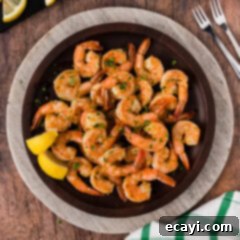
Steamed Shrimp
IMPORTANT – There are often Frequently Asked Questions within the blog post that you may find helpful. Simply scroll back up to read them!
Print It
Pin It
Rate It
Save ItSaved!
Ingredients
- 1 pound large raw shrimp peeled and deveined
- 2 teaspoons garlic salt
- 2 teaspoons Old Bay seasoning
- 1 Tablespoon olive oil
Things You’ll Need
-
Large mixing bowl
-
Steam pot
Before You Begin
- You can easily makeshift a steamer if you don’t already have one. To do so, place a heat-safe colander (such as metal) inside a pot large enough to fit with the lid on, ensuring the water level is below the colander. You can also purchase individual steamer baskets to use with your existing pots.
- To thaw frozen shrimp quickly, place it in a sealed ziptop bag and submerge it in a bowl of cool water. Your shrimp should be thawed in about 40 minutes or so. Change out the water as needed. Never thaw shrimp in warm or hot water, and always pat dry before seasoning.
Instructions
-
In a large mixing bowl, season the peeled and deveined raw shrimp evenly with garlic salt and Old Bay seasoning.1 pound large raw shrimp, 2 teaspoons garlic salt, 2 teaspoons Old Bay seasoning
-
Drizzle the olive oil over the seasoned shrimp and toss gently to ensure every piece is well coated.1 Tablespoon olive oil
-
Add water to the bottom of your steam pot, ensuring it’s about an inch deep and does not touch the steamer basket. Bring the water to a full boil over medium-high heat.
-
Carefully place the seasoned shrimp into the top basket of the steam pot, arranging them to allow steam circulation.
-
Position the basket over the boiling water and immediately cover the pot tightly with its lid to trap the steam.
-
Cook for 5-7 minutes, or until the shrimp turn opaque pink and curl into a ‘C’ shape. Do not overcook.
Expert Tips & FAQs
- Store leftover steamed shrimp in an airtight container in the refrigerator for up to 3 days. Ensure shrimp are cooled completely before storing.
- To reheat, gently warm steamed shrimp in a skillet with a splash of water and a lid for a few minutes over low heat, or in an oven set to 275°F (135°C) for about 8-10 minutes. Avoid microwaving to prevent a rubbery texture.
Nutrition Information
The recipes on this blog are tested with a conventional gas oven and gas stovetop. It’s important to note that some ovens, especially as they age, can cook and bake inconsistently. Using an inexpensive oven thermometer can assure you that your oven is truly heating to the proper temperature. If you use a toaster oven or countertop oven, please keep in mind that they may not distribute heat the same as a conventional full sized oven and you may need to adjust your cooking/baking times. In the case of recipes made with a pressure cooker, air fryer, slow cooker, or other appliance, a link to the appliances we use is listed within each respective recipe. For baking recipes where measurements are given by weight, please note that results may not be the same if cups are used instead, and we can’t guarantee success with that method.
